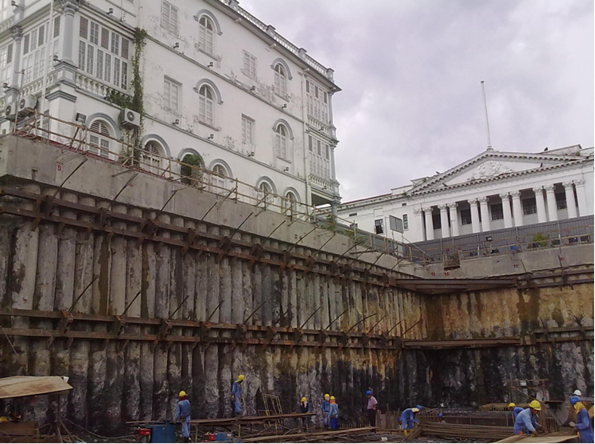Soil-Structure Interaction
A special issue of Geosciences (ISSN 2076-3263). This special issue belongs to the section "Geomechanics".
Deadline for manuscript submissions: closed (31 December 2021) | Viewed by 59126
Special Issue Editors
Interests: soil-structure interaction; underground construction; centrifuge and numerical modelling; characterisation of soils and rocks; forensic engineering
Special Issues, Collections and Topics in MDPI journals
Interests: environmental geotechnics; construction solid waste; underground space engineering
Special Issues, Collections and Topics in MDPI journals
Interests: constitutive modeling of geomaterials; numerical modeling in geotechnical engineering; ground improvement; probabilistic analysis in geotechnical engineering; advanced laboratory and field testing in geotechnical engineering
Special Issue Information
Dear Colleagues,
In today’s world, construction projects tend to be more complex due to one or a combination of the following reasons: climate change impacting design requirements, enhanced material properties, scarcity of greenfield sites in highly built-up cities leading to challenging underground construction, easily accessible scientific knowledge, the prowess of computational speed, and the advent of new technologies driving innovation as well as stringent health and safety requirements to safeguard the public. These factors have since become the new normal, thus increasing the expectations of scientists and engineers to deliver the ‘unimaginable’ products as envisioned by clients.
However, the one aspect of any construction project that has a common link to these expectations is the ground or foundation that these structures sit on. Serving as a platform for buildings and infrastructure to be founded on, soils and rocks are important geomaterials that are challenging to characterise because they are naturally formed, and thus not subject to any quality control protocol.
As such, it is crucial that scientists and engineers develop their expertise and capability through research and practice to quantify the interaction of infrastructure with the surroundings and the ground they are founded on, thus the term ‘soil-structure interaction’ forms an integral part of delivering successful project outcomes.
Therefore, as the honourary Guest Editor for the theme Soil-Structure Interaction, I cordially invite you to submit your articles about your recent project, experimental research or case studies, detailing how geosciences (soil, rock, ground water, geochemistry, geology, hydrogeology, surface run-off, rain, wind, temperature etc.) directly interact with and impact the performance of man-made structures, buildings or infrastructure, through aspects including, but not limited to:
i) Underground construction (e.g., deep excavation, tunnelling, pipe-jacking, trenching);
ii) Innovative ground improvement methods (e.g., DSM, stone column, insitu walls, subgrade stabilisation);
iii) Geological explorations and interpretation;
iv) Onshore/offshore or coastal environment (e.g., jetties, wharves, harbours, wind turbines, underwater landslides, pipelines);
v) Instrumentation and field observational method;
vi) Use of artificial intelligence or algorithms;
vii) Post-failure forensic engineering or inverse-analysis methods;
viii) Geophysical methods for soil or rock characterisation;
ix) Advancements in laboratory and field testing of geomaterials;
x) Advancements in remote sensing/LiDAR/drone/image-processing detection;
xi) Advancements in finite/discrete element/large-deformation/meshfree modelling
xii) Advancements in multi-disciplinary design theories, government policies, construction innovation, engineering education.
I would like to also encourage you to send a brief abstract outlining the purpose of your research and the key results obtained in order to verify at an early stage that your manuscript falls within the objectives of the Special Issue.

Dr. Dominic E.L. Ong
Prof. Dr. Jason Wen Chieh Cheng
Assoc. Prof. Dr. Hannah Zhou
Guest Editors
Manuscript Submission Information
Manuscripts should be submitted online at www.mdpi.com by registering and logging in to this website. Once you are registered, click here to go to the submission form. Manuscripts can be submitted until the deadline. All submissions that pass pre-check are peer-reviewed. Accepted papers will be published continuously in the journal (as soon as accepted) and will be listed together on the special issue website. Research articles, review articles as well as short communications are invited. For planned papers, a title and short abstract (about 100 words) can be sent to the Editorial Office for announcement on this website.
Submitted manuscripts should not have been published previously, nor be under consideration for publication elsewhere (except conference proceedings papers). All manuscripts are thoroughly refereed through a single-blind peer-review process. A guide for authors and other relevant information for submission of manuscripts is available on the Instructions for Authors page. Geosciences is an international peer-reviewed open access monthly journal published by MDPI.
Please visit the Instructions for Authors page before submitting a manuscript. The Article Processing Charge (APC) for publication in this open access journal is 1800 CHF (Swiss Francs). Submitted papers should be well formatted and use good English. Authors may use MDPI's English editing service prior to publication or during author revisions.
Keywords
- Soil-structure interaction
- Underground construction
- Geomaterial testing and characterisation
- Ground improvement and stabilisation
- Forensic engineering
- Structural distress and strengthening
- Damage assessment
- Centrifuge and numerical analyses
- Parametric and case studies
- Artificial intelligence systems.
Benefits of Publishing in a Special Issue
- Ease of navigation: Grouping papers by topic helps scholars navigate broad scope journals more efficiently.
- Greater discoverability: Special Issues support the reach and impact of scientific research. Articles in Special Issues are more discoverable and cited more frequently.
- Expansion of research network: Special Issues facilitate connections among authors, fostering scientific collaborations.
- External promotion: Articles in Special Issues are often promoted through the journal's social media, increasing their visibility.
- e-Book format: Special Issues with more than 10 articles can be published as dedicated e-books, ensuring wide and rapid dissemination.
Further information on MDPI's Special Issue polices can be found here.








